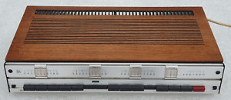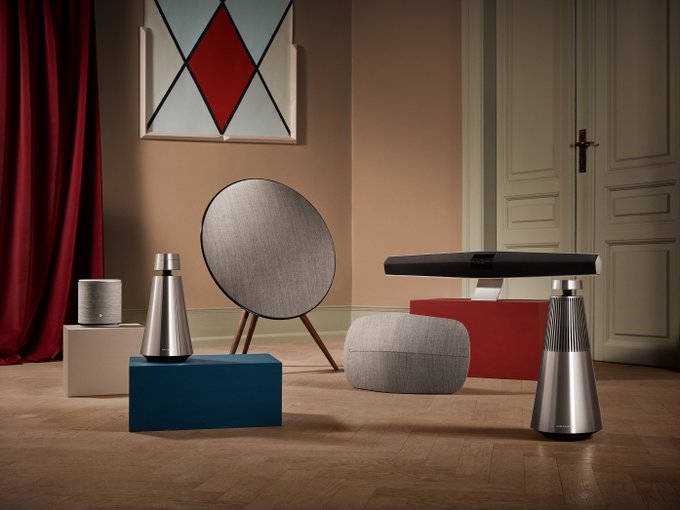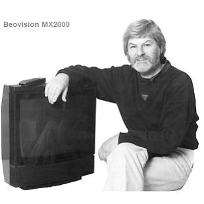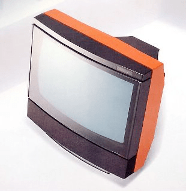
Investigating the connection between Malevich´s Black Square Painting and Bang & Olufsen (Part 2 of 2)
Click here for Part 1: The Artistic Disruption and its Ripple Effect on Business
Part 2 – Malevich and Bang & Olufsen – Art and tech intertwined
Bang & Olufsen’s captivating success story began in 1925 in an attic, in contrast to the traditional garage setting of other famous companies like Apple, Microsoft, or Hewlett-Packard.
Founded by Svend Olufsen and Peter Bang, Bang & Olufsen (B&O) is based in remote Struer, Northwest Denmark, surrounded by farms and fjords. B&O has become a global leader in high-end audio and video, showcasing the intertwining of art and technology for almost a century.
Despite not being headquartered in a key region, the company has defied convention and set a precedent for remote location companies like Zara, Walmart, and Patagonia.
In 1967, Jacob Jensen designed Beolab 5000, which proved to be a milestone product for the company.
Art-Tech Intertwined for a Competitive Edge
Amplifiers in the 1960´s
B&O
AG9016 –Beolab 5000 Amplifier (1967)

Philips
AG9016 – Classic 1960s stereo tube amplifier

The amplifier designed by Jacob shows simple and clean shapes that create a modern, minimalist look aligned with the work of Malevich. The mix of materials (Metal, wood and glass) shows the influence of the work of Vladimir Tatlin (1885-1953), a colleague of Malevich that has revolutionized the concept of sculptures in the Art world (Please refer to the Article “Tatlin’s Sculptures: Disrupting Market Mind Barriers”)
Jacob once challenged the engineers to make a radio less than 7 cm high, but they said it was impossible because the transformer was 8 cm high. Jacob persisted and eventually, they discovered a new type of transformer that allowed for the 7-cm-high radio. He stuck to his ideas and convictions, refusing to be popular, which proved to be successful in the end.
| Jacob once challenged the engineers to make a radio less than 7 cm high, but they said it was impossible because the transformer was 8 cm high. Jacob persisted and eventually, they discovered a new type of transformer that allowed for the 7-cm-high radio. He stuck to his ideas and convictions, refusing to be popular, which proved to be successful in the end. |
In 1978, the Museum of Modern Art in NYC (MoMA) exhibited Bang & Olufsen: Design for Sound by Jakob Jensen (https://www.moma.org/calendar/exhibitions/1786). The design curator, J. Stewart Johnson, praised their ability to visually de-emphasize the technical aspects of their equipment’s, making them virtual abstractions of the functions they are meant to perform and creating beautiful objects for the home.
On the other hand, B&O wasn’t particularly radical for the first thirty years and they made products that looked pretty much similar to everybody else’s, focusing instead on technology and innovation. But in the mid-1950s something happened, and B&O began to take a different shape.
In 1954, a Copenhagen exhibition marked a turning point in Danish furniture design, inspired by artists such as Kazimir Malevich and Vladimir Tatlin from the Suprematist art movement.
Distinguished architects like Arne Jacobsen and Hans Wegner provided guidance to young designers, encouraging them to explore new, simple, and linear shapes, as well as combinations of materials. This led to a rise in popularity of teak wood and bold colors, resulting in more vibrant and cheerful home environments.
The exhibition presented radio cabinets as essential living room features, but they received harsh criticism from architect Poul Henningsen for their poor design, which he deemed an insult to modern furniture. He even asked if they were designed by potato wholesalers with nothing better to do in their spare time.
Heeding the criticism, B&O began a close collaboration with external designers that would come to define the company’s way of working. Architect Ib Fabiansen was one of the first to really instigate a new direction for the brand.
A look at the B&O products from the last fifty years reveals the work of many talented designers, but two designers stand out from the crowd: one of them is Jacob Jensen, who was mentioned earlier, for his work on the audio side from the 1960s to the 1990s, and the other is David Lewis for his work on the video and speaker side from the 1960s to the 2010s.
Between them they designed many of the products that have made the company famous.
Jacob, with his tough and demanding persona, was also known for his charming and fun-loving nature. As for David was quiet, reserved, but equally determined.
Although their personalities were two poles apart, they were still able to work together effectively. Despite their frequent disagreements, they both had unique qualities that combined contributed for the success of the company. Indeed, each in his own way, David and Jacob interpreted the spirit of B&O at exactly the right time.
Under David, the concept of movement and light was refined, as was the understanding that the products needed to stand out as beautiful objects, and blend in with the home environment at the same time.
| Once, my firm gave me a new black portable computer with upgraded tech, but the same old design and color. My wife couldn’t tell it apart from the old model. It was the only product that didn’t change in my personal and home decor for five years. It seemed like it was designed by potato wholesalers. Hint: it wasn’t an Apple.
Can you think of any products or brands where art and technology are not intertwined? Personally, I think that most air conditioning brands still look unattractive in well-decorated living rooms |
| When one gets married, one looks for someone who shares our tastes, habits, and sense of humor. But in business, we often need people who bring different perspectives and skills to the table.
Having a duo of leaders with contrasting personalities, complementary talents and backgrounds at the top of a company, or a startup, can result in exponential success, as seen with Apple’s Steve Jobs and Steve Wozniak or Spotify’s Martin Lorentzon and Daniel Ek. It´s crucial to effectively manage these relationships to harness their genius, particularly since there is a growing risk of deterioration over time. Ensuring that genuine talent exists before investing time is also essential. |
In the 1980s, David Lewis designed a completely different kind of TV: Beovision MX2000. In terms of design, color and uses it was a departure from tradition.
The focus of Beovision MX2000 on simple shapes, bold colors, and minimalism shows a clear influence of the work of Malevich.
The choice of color for MX2000 was a matter of personal taste, and style. The choice was ours: rich red for a home abounding in color and striking contrasts; elegant white; distinguished metallic grey; or black to go with most color schemes.
Art-Tech Intertwined for a Competitive Edge
TV Sets in the 1960´s
David Lewis’s design on the Beovision MX2000 was detailed and highly aesthetical which made the TV look good from all angles. This Beovision model gives an impression of lightness and provides extended freedom of positioning.
Then, all of a sudden, a TV Set could be placed anywhere, even in the middle of a room. Thanks to its pyramidal shape, the TV was also suitable for placement in corners
Moreover, B&O not only repositioned their TV set as a consumer electronic product but also as a living room design piece, In this way, B&O redefined an everyday object and gave it a novel significance. Akin to Marcel Duchamp’s “Fountain” (1917), where the artist transformed an ordinary urinal into a work of art.
Positioned as a statement piece in the living room, the Beovision MX2000 could exude glamour and sophistication, appealing to two segments of customers’ wallets (TV entertainment and living room decor). This unique positioning made it easier to command a high-end market price.
Since the 1978 MOMA exhibition, several of David Lewis’s designs have been acquired by the museum, adding to its collection of Jacob Jensen’s work.
In the business realm, the 2008 economic crisis hit Bang & Olufsen hard, causing a significant drop in revenue and stock prices. Despite partnerships with prestigious auto brands like Aston Martin, BMW, Mercedes-Benz, and Ferrari, extensive restructuring, divestitures, and the addition of new Chinese shareholders mainly for Asian expansion, the company still faces ongoing challenges in its quest to recover its former glory.
Quirk and Curiosities
In Struer, 357 km away from Copenhagen, for almost a century, dedicated specialists have showcased innovative design, superior technology, and quality workmanship, make a company with a unique brand in the industry.
The spirit of Struer has reached far and wide, and the lessons learned from this small town are invaluable. When you visit Struer, you will quickly notice that Bang & Olufsen is the town’s most significant business, employing almost a third of the population.
The Factory 4 canteen has a “Wall of Fame” with 1,230 portraits of 25-year employees, including co-founder Peter Bang’s. Svend Olufsen, who died before his 25th anniversary, is absent. All Danish must meet rules.
Make sure to visit the Struer Museum, where you can see old and new Bang & Olufsen products alongside iconic pieces of Danish design furniture.
In the museum, you can observe the pieces designed by Jacob Jensen and David Lewis. David was a Londoner who met a Danish au pair in the 1960s and followed her to Denmark. David was happy in the country that is ranked the second happiest in the world.
The museum also dedicates a lot of space to the founders and the company’s history, including Peter Bang’s involvement in developing a transmitter for the Resistance during World War II.
After your visit to the museum, take some time to explore the town and its attractions.
You can visit the churches and cathedral, unwind and enjoy the wonderful thermal experiences right at the fjord, and have dinner at the Værftet (shipyard) Café & Restaurant, located in the old industrial section of the harbor. The restaurant boasts a modern building with a spectacular view of the fjord, and you can also try the famous Limfjord oysters.
Hope you and your family will enjoy the trip.
Ah! One last thing, end the night with a nice brew and a stick steak at the Happy Penguin Pub !
Jose Taboada – Corporate Strategist | Founder of Artcipation
Key Sources: Will Gompertz; Tate Museum; Alastair Philip Wiper
© 2024 Artcipation
Comment Article on:
Do you want to receive more information about this topic?
Subscribe our Mailing List today!






